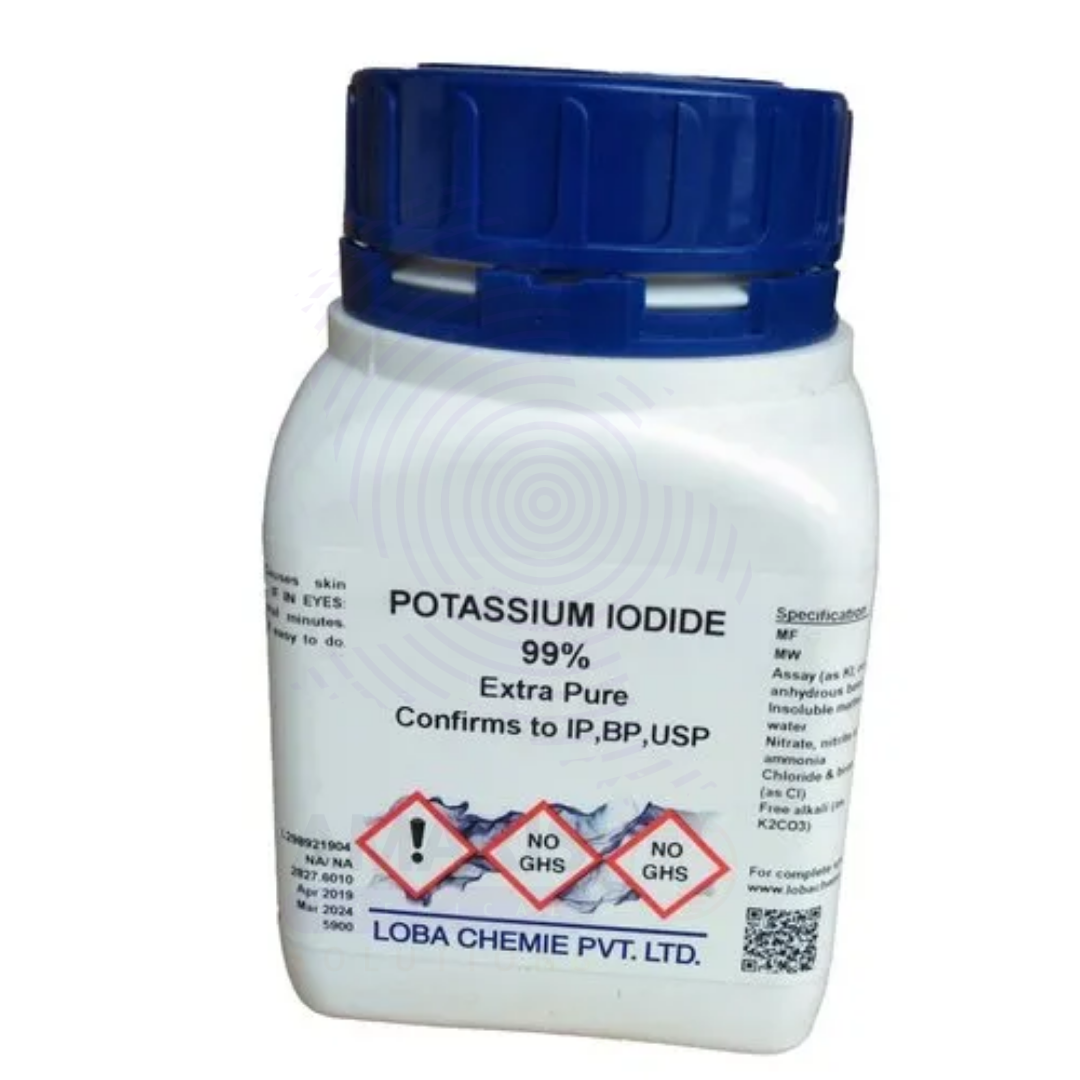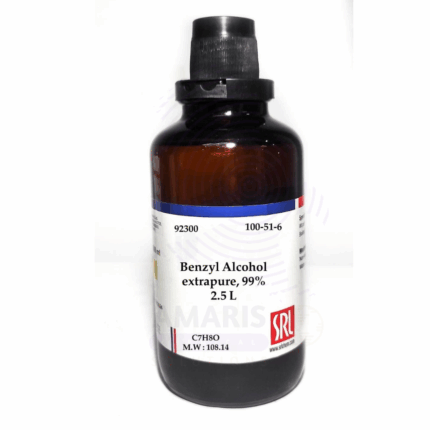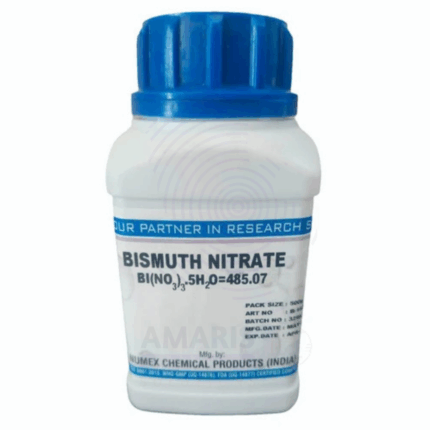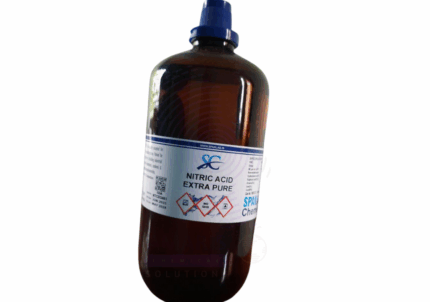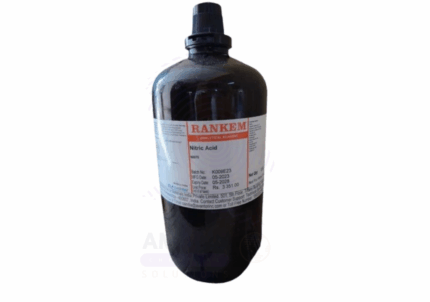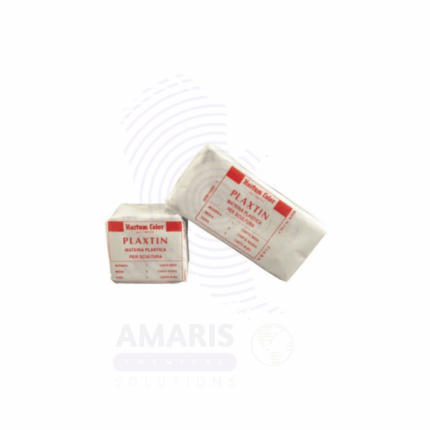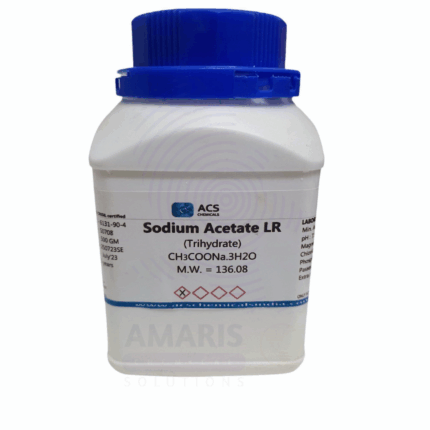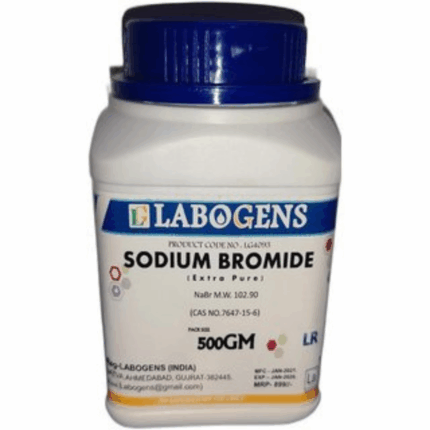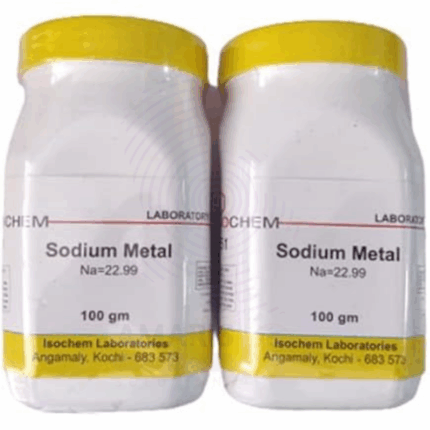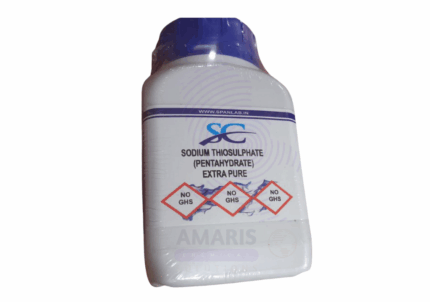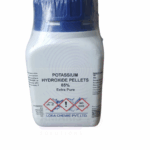
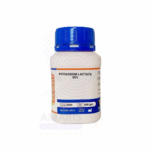
Potassium Iodide Extra Pure
$ 21.15
Potassium Iodide Extra Pure is a high-purity, white crystalline salt widely recognized for its excellent solubility in water and its versatile applications. In laboratories, it is commonly used as a reagent in iodometric titrations and for preparing iodine solutions. In the medical field, it serves as a key source of iodine and is used for thyroid protection against radioactive iodine exposure. Its antioxidant properties also make it valuable in pharmaceutical formulations and as a stabilizer in various chemical processes. The extra pure grade ensures maximum consistency and reliability for precise experimental and industrial outcomes.
Potassium Iodide Extra Pure
PRIMARY USES
- Pharmaceuticals & Medical Applications:
- Used as a thyroid blocker during radiation emergencies to prevent radioactive iodine uptake.
- Employed in the treatment of iodine deficiency, hyperthyroidism, and goiter.
- Included in expectorants to help loosen mucus in respiratory conditions.
- Laboratory Reagent:
- Used in iodometric titrations and analytical chemistry to detect oxidizing agents.
- Reacts with chlorine or hydrogen peroxide to release free iodine for analytical purposes.
- Photography & Film Processing:
- Formerly used in preparing photographic emulsions and developers.
- Chemical Synthesis:
- Source of iodide ions in various organic and inorganic reactions.
- Used in preparing alkyl iodides and other iodinated compounds.
SECONDARY USES
- Nutritional Supplementation:
- Added to table salt to produce iodized salt, preventing iodine deficiency disorders.
- Animal Feed:
- Included in livestock feed formulations to support thyroid function in animals.
- Disinfectants & Antiseptics:
- Used with iodine to make Lugol’s solution and other iodine-based disinfectants.
- Textile and Dye Industry:
- Used in some staining procedures and fixation processes.
1. Basic Identification Attributes
- Chemical Name: Potassium Iodide
- CAS Number: 7681-11-0
- HS Code: 2827.60.00
- Molecular Formula: KI
- Synonyms:
- KI
- Iodide of potash
- Potassium salt of hydroiodic acid
2. Physical & Chemical Properties
- Physical State: Solid (crystalline powder or granules)
- Color & Odor: White or colorless; odorless
- Boiling Point & Melting Point:
- Melting Point: ~681 °C
- Boiling Point: Decomposes before boiling
- Density/Specific Gravity: ~3.13 g/cm³
- Solubility:
- Highly soluble in water (140–150 g/100 mL at 20 °C)
- Slightly soluble in ethanol and glycerol
- pH Level: ~6–10 (5% aqueous solution)
- Vapor Pressure & Volatility: Negligible vapor pressure
- Flash Point: Not flammable
- Autoignition Temperature: Not applicable
- Viscosity: Not applicable (solid)
3. Safety & Hazard Attributes
- Hazard Class (GHS Classification):
- Eye irritation (Category 2A)
- May cause thyroid effects at high doses
- NFPA Ratings:
- Health: 2
- Flammability: 0
- Reactivity: 0
- Exposure Limits:
- OSHA PEL: Not established
- ACGIH TLV: Not established (consult local authority)
- Reactivity:
- Stable under normal conditions
- Incompatible with strong oxidizing agents and acids
4. Storage & Handling Attributes
- Storage Conditions:
- Store in tightly sealed containers
- Keep in a cool, dry, and dark place to avoid iodide oxidation
- Incompatible Materials:
- Strong acids, oxidizers, and halogens
- Container Type:
- Glass or HDPE bottles with tight-seal caps
- Shelf Life & Expiration Date:
- Several years if kept dry and away from light
- Special Handling Requirements:
- Use gloves, goggles, and dust mask if handling large quantities
- Prevent exposure to light and moisture
5. Regulatory & Compliance Attributes
- Regulatory Status:
- Listed by TSCA, REACH, and other regulatory bodies
- Transportation Restrictions:
- Not classified as hazardous for transport
- Waste Disposal Method:
- Dispose of in accordance with local environmental regulations
- Avoid release to the environment
6. Environmental & Health Impact
- Ecotoxicity:
- Low acute toxicity to aquatic life
- Persistence in Environment:
- Reacts to form iodates or elemental iodine in presence of air/light
- Carcinogenicity/Mutagenicity:
- Not classified as carcinogenic or mutagenic by IARC/OSHA
- Biodegradability:
- Inorganic substance; does not biodegrade but disperses in environment
SAFETY PRECAUTIONS
Personal Protective Equipment (PPE):
- Protective safety goggles or chemical-resistant face shield
- Lab coat or protective apron
- Gloves (nitrile or PVC recommended)
- Use dust mask or respirator in poorly ventilated areas or when handling large quantities
Handling:
- Avoid inhalation of dust and contact with eyes or skin
- Use in a well-ventilated area or under a fume hood
- Keep container tightly sealed when not in use
- Wash thoroughly after handling
Storage:
- Store in a cool, dry, well-ventilated area
- Keep container tightly closed
- Protect from moisture and light
- Store away from strong acids and oxidizing agents
FIRST AID MEASURES
Inhalation:
- Move person to fresh air immediately
- Keep at rest and seek medical attention if symptoms develop
Skin Contact:
- Wash skin with plenty of water and soap
- Remove contaminated clothing
- Seek medical advice if irritation persists
Eye Contact:
- Rinse cautiously with water for at least 15 minutes
- Lift eyelids to ensure thorough flushing
- Get medical attention immediately
Ingestion:
- Rinse mouth with water
- Do not induce vomiting unless instructed by medical personnel
- Drink water or milk if conscious
- Seek prompt medical attention
FIRE FIGHTING MEASURES
Flammability:
- Non-flammable
Extinguishing Media:
- Use water spray, dry chemical, foam, or carbon dioxide
- Choose extinguishing media suitable for surrounding fire
Hazardous Combustion Products:
- Emits toxic fumes of iodine and potassium oxides under fire conditions
Firefighter Protection:
- Wear self-contained breathing apparatus (SCBA) and full protective clothing
- Prevent runoff from fire control from entering waterways or sewers


 Preservatives(food)
Preservatives(food) Flavor Enhancers
Flavor Enhancers Acidulants
Acidulants Sweeteners
Sweeteners Antioxidants
Antioxidants Colorants(food)
Colorants(food) Nutraceutical Ingredients (food)
Nutraceutical Ingredients (food) Nutrient Supplements
Nutrient Supplements Emulsifiers
Emulsifiers
 Collectors
Collectors Dust Suppressants
Dust Suppressants Explosives and Blasting Agents
Explosives and Blasting Agents Flocculants and Coagulants
Flocculants and Coagulants Frothers
Frothers Leaching Agents
Leaching Agents pH Modifiers
pH Modifiers Precious Metal Extraction Agents
Precious Metal Extraction Agents
 Antioxidants(plastic)
Antioxidants(plastic) Colorants (Pigments, Dyes)
Colorants (Pigments, Dyes) Fillers and Reinforcements
Fillers and Reinforcements Flame Retardants
Flame Retardants Monomers
Monomers Plasticizers
Plasticizers Polymerization Initiators
Polymerization Initiators Stabilizers (UV, Heat)
Stabilizers (UV, Heat)
 Antifoaming Agents
Antifoaming Agents Chelating Agents
Chelating Agents Coagulants and Flocculants
Coagulants and Flocculants Corrosion Inhibitors
Corrosion Inhibitors Disinfectants and Biocides
Disinfectants and Biocides Oxidizing Agents
Oxidizing Agents pH Adjusters
pH Adjusters Scale Inhibitors( water)
Scale Inhibitors( water)
 Antioxidants(cosmetic)
Antioxidants(cosmetic) Emollients
Emollients Fragrances and Essential Oils
Fragrances and Essential Oils Humectants
Humectants Preservatives
Preservatives Surfactants(cosmetic)
Surfactants(cosmetic) Thickeners
Thickeners UV Filters
UV Filters
 Fertilizers
Fertilizers Soil Conditioners
Soil Conditioners Plant Growth Regulators
Plant Growth Regulators Animal Feed Additives
Animal Feed Additives Biostimulants
Biostimulants Pesticides (Herbicides, Insecticides, Fungicides)
Pesticides (Herbicides, Insecticides, Fungicides)
 Active Pharmaceutical Ingredients (APIs)
Active Pharmaceutical Ingredients (APIs) Excipients
Excipients Solvents(pharmaceutical)
Solvents(pharmaceutical) Antibiotics
Antibiotics Antiseptics and Disinfectants
Antiseptics and Disinfectants Vaccine Adjuvants
Vaccine Adjuvants Nutraceutical Ingredients (pharmaceutical)
Nutraceutical Ingredients (pharmaceutical) Analgesics & Antipyretics
Analgesics & Antipyretics
 Analytical Reagents
Analytical Reagents Solvents(lab)
Solvents(lab) Chromatography Chemicals
Chromatography Chemicals Spectroscopy Reagents
Spectroscopy Reagents microbiology-and-cell-culture-reagents
microbiology-and-cell-culture-reagents Molecular Biology Reagents
Molecular Biology Reagents Biochemical Reagents
Biochemical Reagents Inorganic and Organic Standards
Inorganic and Organic Standards Laboratory Safety Chemicals
Laboratory Safety Chemicals Specialty Laboratory Chemicals(Special Laboratory Equipment)
Specialty Laboratory Chemicals(Special Laboratory Equipment)
 Demulsifiers
Demulsifiers Hydraulic Fracturing Fluids
Hydraulic Fracturing Fluids Scale Inhibitors(oil)
Scale Inhibitors(oil) Surfactants(oil)
Surfactants(oil) Drilling Fluids
Drilling Fluids
 Dyes and Pigments
Dyes and Pigments Bleaching Agents
Bleaching Agents Softening Agents
Softening Agents Finishing Agents
Finishing Agents Antistatic Agents
Antistatic Agents
 Admixtures
Admixtures Waterproofing Agents
Waterproofing Agents Sealants and Adhesives
Sealants and Adhesives Curing Compounds
Curing Compounds Concrete Repair Chemicals
Concrete Repair Chemicals Anti-Corrosion Coatings
Anti-Corrosion Coatings
 Surfactants(cleaning)
Surfactants(cleaning) Builders
Builders Enzymes
Enzymes Solvents (Cleaning)
Solvents (Cleaning) Fragrances
Fragrances
 Electronic Chemicals
Electronic Chemicals Catalysts
Catalysts Lubricants
Lubricants Photographic Chemicals
Photographic Chemicals Refrigerants
Refrigerants Automotive chemicals
Automotive chemicals Pyrotechnic Chemicals
Pyrotechnic Chemicals
 Biodegradable Surfactants
Biodegradable Surfactants Bio-based Solvents
Bio-based Solvents Renewable Polymers
Renewable Polymers Carbon Capture Chemicals
Carbon Capture Chemicals Wastewater Treatment Chemicals
Wastewater Treatment Chemicals
 Pigments
Pigments Solvents(paint)
Solvents(paint) Specialty Coatings
Specialty Coatings Binders/Resins
Binders/Resins Additives
Additives Driers
Driers Anti-Corrosion Agents
Anti-Corrosion Agents Functional Coatings
Functional Coatings Application-Specific Coatings
Application-Specific Coatings
 Fresh Herbs
Fresh Herbs Ground Spices
Ground Spices Whole Spices
Whole Spices Spice Blends
Spice Blends Dried Herbs
Dried Herbs
 Leavening Agents
Leavening Agents Dough Conditioners
Dough Conditioners Flour Treatments
Flour Treatments Fat Replacers
Fat Replacers Decoratives
Decoratives Preservatives(baking)
Preservatives(baking)
 Plasticizers & Softeners
Plasticizers & Softeners Reinforcing Agents
Reinforcing Agents Adhesion Promoters
Adhesion Promoters Vulcanizing Agents
Vulcanizing Agents Antidegradants
Antidegradants Blowing Agents
Blowing Agents Fillers & Extenders
Fillers & Extenders Accelerators & Retarders
Accelerators & Retarders